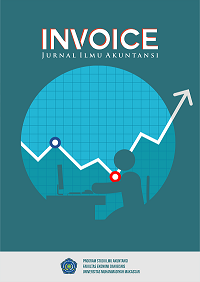The Effect Of Current Ratio, Debt To Equity Ratio, Debt To Asset Ratio And Time Interest Earned Ratio On Profit Growth at PT Aneka Tambang tbk
Abstract
This study is anssociative studyat that at aims to determine the effect of current ratio, debt to equity ratio, debt to Asset Rasio and Time Interest Earned Ratio on profit grown at PT. Aneka Tambang Tbk. This study uses financial reports with a population of 20 year and the sample used is 9 years. The date collection techniquens used in this study are documentation and literature study. The data analysis technique used is multiple linear regression test, namely the statistical method of classical assumption test multicollinearity heteroscedasticity multiple linear regression t test f test and coefficien of determination. The research result is There is no influence of Current Ratio, Debt to Equity Ratio, Det to Asset Ratio, and Time Interest Earned Ratio to profit growth at PT Aneka Tambang TbkReferences
Agustina dan Silvia, 2012. “Pengaruh Rasio Keuangan Terhadap Perubahan Laba Pada Perusahaan Manufaktur Yang Terdaftar Di Bursa Efek Indonesia”. Jurnal Wira Ekonomi Mikroskil, Volume 2, Nomor 02 Oktober 2012.
Abdullah, et al. 2016. Pengaruh EPS, DER, PER, ROA, Dan ROE Terhadap Harga Saham Pada Perusahaan Tambang Yang Terdaftar Di BEI Untuk Periode 2011-2013. DINAMIKA EKONOMI Jurnal Ekonomi dan Bisnis, 9(1):1-20
Alipudin, A., dan Resi O. 2016. Pengaruh EPS, ROE, ROA, Dan DER Terhadap Harga Saham Pada Perusahaan Sub Sektor Semen Yang Terdaftar Di BEI. JIAFE : Jurnal Ilmiah Akuntansi Fakultas Ekonomi, 2(1):1-22
Amaliyah, N.F., et al. 2017. Pengaruh Earning Per Share (EPS), Price Earning Ratio (PER), Price To Book Value (PBV), Dan Debt To Equity Ratio (DER) Terhadap Harga Saham Pada Perusahaan Indeks Saham Syariah Indonesia (ISSI). Jurnal ECOBUSS, 5(2):29-40
Brigham, F. Eugene dan Joel F. Houston. 2010. Essentials of Financial Management, 2nd Edition. Singapore : Cengange Learning.
Darsono, Azhari. 2005. Pedoman Praktisi Memahami Laporan Keuangan, Andi, Yogyakarta
Gunawan, A. D. E., & Wahyuni, S. R. I. F. (2013). 1 , 2 1. 13(01), 63–84.PENGARUH RASIO KEUANGAN TERHADAP PERTUMBUHAN LABA PADA PERUSAHAAN PERTAMBANGAN YANG TERDAFTAR DI BURSA EFEK INDONESIA Ima Andriyani 1. (n.d.).
Hari S, Nita dan Siti Rokhmi F. 2014. “Analisis Rasio Keuangan untuk Memprediksi Pertumbuhan Laba Perusahaan Otomotif di BEI”. Jurnal Ilmu dan Riset Manajemen, Vol. 3, No. 5. Sekolah Tinggi Ilmu Ekonomi Indonesia (STIESIA) Surabaya...
Indarti, Iin. (2002). Analisis Rasio Keuangan dalam Memprediksi Perubahan Laba Emiten di BEJ Tahun 1997-1999. ASSETS. Jurnal Ekonomi dan Bisnis
Indonesia.Vol. 4, no. 2, Juni 2002.
Ikatan Akuntan Indonesia. (2007). Standar Akuntansi Keuangan Per 1 April. Jakarta: Penerbit Salemba Empat.
Kasmir. 2016. Pengantar Manajemen Keuangan: Edisi Kedua. Jakarta: Prenada Media
Kasmir. (2018). Analisis Laporan Keuangan. Depok: Rajawali Pers.
Kariyoto. 2018. Manajemen Keuangan: Konsep dan Implementasi. Malang: Universitas Brawijaya Press
Sawir, Agnes, 2009. Analisa Kinerja Keuangan dan Perencanaan keauangan
Perusahaan, PT. Gramedia Pustaka Utama, Jakarta.
Sari, Linda Purnama. 2015. Analisis Pengaruh Rasio Keuangan Terhadap Pertumbuhan Laba (Studi Kasus : Perusahaan Food And Beverages Yang Terdaftar Di Bursa Efek Indonesia Periode 2009 Sampai Dengan 2013). Skripsi. Fakultas Ekonomika Dan Bisnis. Universitas Diponegoro,Semarang..
Suprihartimi (2006). Ekonomi Lanjutan. Penerbit Graha Ilmu Yogyakarta
Sari, Linda Purnama. 2015. Analisis Pengaruh Rasio Keuangan Terhadap Pertumbuhan Laba (Studi Kasus : Perusahaan Food And Beverages Yang Terdaftar Di Bursa Efek Indonesia Periode 2009 Sampai Dengan 2013). Skripsi. Fakultas Ekonomika Dan Bisnis. Universitas Diponegoro, Semarang.
Syamsudin, Lukman. (2009). Manajemen Keuangan Perusahaan. Edisi Baru. Jakarta: PT. Rajagrafindo Persada.
Downloads
Published
Issue
Section
License
Authors who publish with Invoice: Jurnal Ilmu Akuntansi agree to the following terms:
Copyright Ownership
The copyright of all articles published in this journal remains with the author(s). However, the authors grant Invoice: Jurnal Ilmu Akuntansi the right of first publication with the work simultaneously licensed under a Creative Commons Attribution 4.0 International License (CC BY 4.0). This license allows others to share, copy, redistribute, adapt, and build upon the work for any purpose, even commercially, as long as proper credit is given to the original author(s) and the source.Licensing and Access
Invoice: Jurnal Ilmu Akuntansi provides immediate open access to its content on the principle that making research freely available to the public supports a greater global exchange of knowledge. All published materials are available freely without subscription or payment and can be accessed, downloaded, and reused by any user provided that appropriate attribution is given.Permission for Reuse
For uses not covered by the CC BY 4.0 license, such as commercial reprints, translations, or any form of adaptation without clear attribution, users must obtain written permission from the editorial team. Requests for such permissions can be directed to the editorial office at: [insert journal email here].Plagiarism and Originality
Authors are responsible for the originality of their submissions. All articles are screened for plagiarism using appropriate tools before acceptance. Manuscripts found to contain unoriginal content or infringing materials will be rejected or retracted as per journal policy.

